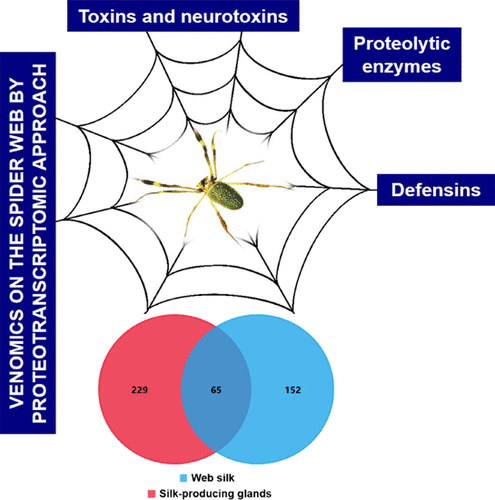当前位置:
X-MOL 学术
›
J. Proteome Res.
›
论文详情
Our official English website, www.x-mol.net, welcomes your
feedback! (Note: you will need to create a separate account there.)
Revealing the Venomous Secrets of the Spider's Web.
Journal of Proteome Research ( IF 3.8 ) Pub Date : 2020-06-15 , DOI: 10.1021/acs.jproteome.0c00086 Franciele Grego Esteves 1 , José Roberto Aparecido Dos Santos-Pinto 1 , Milene Ferro 1 , Fernando J Sialana 2 , Roman Smidak 2 , Lucaciu Calin Rares 3 , Thomas Nussbaumer 3 , Thomas Rattei 3 , Martin Bilban 4 , Mauricio Bacci Júnior 1 , Gert Lubec 5 , Mario Sergio Palma 1
Journal of Proteome Research ( IF 3.8 ) Pub Date : 2020-06-15 , DOI: 10.1021/acs.jproteome.0c00086 Franciele Grego Esteves 1 , José Roberto Aparecido Dos Santos-Pinto 1 , Milene Ferro 1 , Fernando J Sialana 2 , Roman Smidak 2 , Lucaciu Calin Rares 3 , Thomas Nussbaumer 3 , Thomas Rattei 3 , Martin Bilban 4 , Mauricio Bacci Júnior 1 , Gert Lubec 5 , Mario Sergio Palma 1
Affiliation

|
Orb-weaving spiders use a highly strong, sticky and elastic web to catch their prey. These web properties alone would be enough for the entrapment of prey; however, these spiders may be hiding venomous secrets in the web, which current research is revealing. Here, we provide strong proteotranscriptomic evidence for the presence of toxin/neurotoxin-like proteins, defensins, and proteolytic enzymes on the web silk from Nephila clavipes spider. The results from quantitative-based transcriptomic and proteomic approaches showed that silk-producing glands produce an extensive repertoire of toxin/neurotoxin-like proteins, similar to those already reported in spider venoms. Meanwhile, the insect toxicity results demonstrated that these toxic components can be lethal and/or paralytic chemical weapons used for prey capture on the web, and the presence of fatty acids in the web may be a responsible mechanism opening the way to the web toxins for accessing the interior of prey’s body, as shown here. Comparative phylogenomic-level evolutionary analyses revealed orthologous genes among two spider groups, Araneomorphae and Mygalomorphae, and the findings showed protein sequences similar to toxins found in the taxa Scorpiones and Hymenoptera in addition to Araneae. Overall, these data represent a valuable resource to further investigate other spider web toxin systems and also suggest that N. clavipes web is not a passive mechanical trap for prey capture, but it exerts an active role in prey paralysis/killing using a series of neurotoxins.
中文翻译:

揭示蜘蛛网的有毒秘密。
织珠蜘蛛使用高强度,粘性和弹性的网捕捉猎物。仅这些网络属性就足以捕获猎物。但是,这些蜘蛛可能正在网络中隐藏有毒的秘密,当前的研究表明。在这里,我们提供了强有力的蛋白转录组学证据,证明Nephila clavipes的网丝上存在毒素/神经毒素样蛋白,防御素和蛋白水解酶。蜘蛛。基于定量的转录组学和蛋白质组学方法的结果表明,产丝腺可产生大量的毒素/神经毒素样蛋白,类似于蜘蛛毒液中已经报道的那些。同时,昆虫的毒性结果表明,这些有毒成分可能是致命的和/或麻痹性化学武器,用于在网上捕获猎物,并且网中脂肪酸的存在可能是负责任的机制,为网中的毒素打开了途径。进入猎物的身体内部,如图所示。比较的系统生物学水平的进化分析揭示了两个蜘蛛群(Araneomorphae和Mygalomorphae)之间的直系同源基因,研究结果表明,与Araneae相似,蛋白质序列类似于在类群蝎和膜翅目中发现的毒素。总体,锁骨猪笼草网并不是捕获猎物的被动机械陷阱,但它在使用一系列神经毒素的猎物麻痹/杀死中发挥了积极作用。
更新日期:2020-08-08
中文翻译:

揭示蜘蛛网的有毒秘密。
织珠蜘蛛使用高强度,粘性和弹性的网捕捉猎物。仅这些网络属性就足以捕获猎物。但是,这些蜘蛛可能正在网络中隐藏有毒的秘密,当前的研究表明。在这里,我们提供了强有力的蛋白转录组学证据,证明Nephila clavipes的网丝上存在毒素/神经毒素样蛋白,防御素和蛋白水解酶。蜘蛛。基于定量的转录组学和蛋白质组学方法的结果表明,产丝腺可产生大量的毒素/神经毒素样蛋白,类似于蜘蛛毒液中已经报道的那些。同时,昆虫的毒性结果表明,这些有毒成分可能是致命的和/或麻痹性化学武器,用于在网上捕获猎物,并且网中脂肪酸的存在可能是负责任的机制,为网中的毒素打开了途径。进入猎物的身体内部,如图所示。比较的系统生物学水平的进化分析揭示了两个蜘蛛群(Araneomorphae和Mygalomorphae)之间的直系同源基因,研究结果表明,与Araneae相似,蛋白质序列类似于在类群蝎和膜翅目中发现的毒素。总体,锁骨猪笼草网并不是捕获猎物的被动机械陷阱,但它在使用一系列神经毒素的猎物麻痹/杀死中发挥了积极作用。







































 京公网安备 11010802027423号
京公网安备 11010802027423号